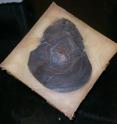As teeth grow in layers, each layer will preserve some of the chemicals present in the environment around them. A team of palaeontologists were able to look at two distinct isotopic signatures within the teeth of giant Sauropod dinosaurs to determine whether they were living on high or low ground.
 |
| One of the Edmontosaurus bones used in the study |
They found that these creatures migrated and alternated their environment with the seasons. Yet researchers from the University of Cape Town, the Museum of Nature and Science in Dallas and Temple University have found that some dinosaurs did the opposite, enduring harsh winters for months on end.
Excavations, led by Anthony Fiorillo from Nature and Science, at the Cretaceous rocks at Alaska's North Slope, have produced a series 70 million year old bones from Edmontosaurus and Pachyrhinosaurus.
Excavations, led by Anthony Fiorillo from Nature and Science, at the Cretaceous rocks at Alaska's North Slope, have produced a series 70 million year old bones from Edmontosaurus and Pachyrhinosaurus.
By analyzing the micro-structures within the bones, they were able to reconstruct the periods of fast and slow growth. By chance, researchers from Cape Town were completing a similar study. The two teams decided to combine their data to provide a wider and more accurate sample. The trend was still the same.The bones showed a reasonably steady growth which slowed down for a brief period in the year.
The researchers linked this to climate, suggesting that the period of slow growth was during the winter.The only way this could have been possible was if the dinosaurs remained in the same place during the cold season. 'What we found was that periodically, throughout their life, these dinosaurs were switching how fast they were growing' said Allison Tumarkin-Deratzian from Temple University.
'We interpreted this as potentially a seasonal pattern because we know in modern animals these types of shifts can be induced by changes in nutrition. But that shift is often driven by changes in seasonality.' As the bones were present in the same geological horizon, Fiorillo believes that they were killed and buried by sediment from a flash flood. 'They are very similar to modern flood deposits that happen in Alaska in the spring when you get spring melt water coming off the Brooks Mountain Range' said Fiorillo. The ability to analyse fossils at the microscopic and molecular level will become increasingly useful as we try to reconstruct the lifestyle of long extinct creatures.